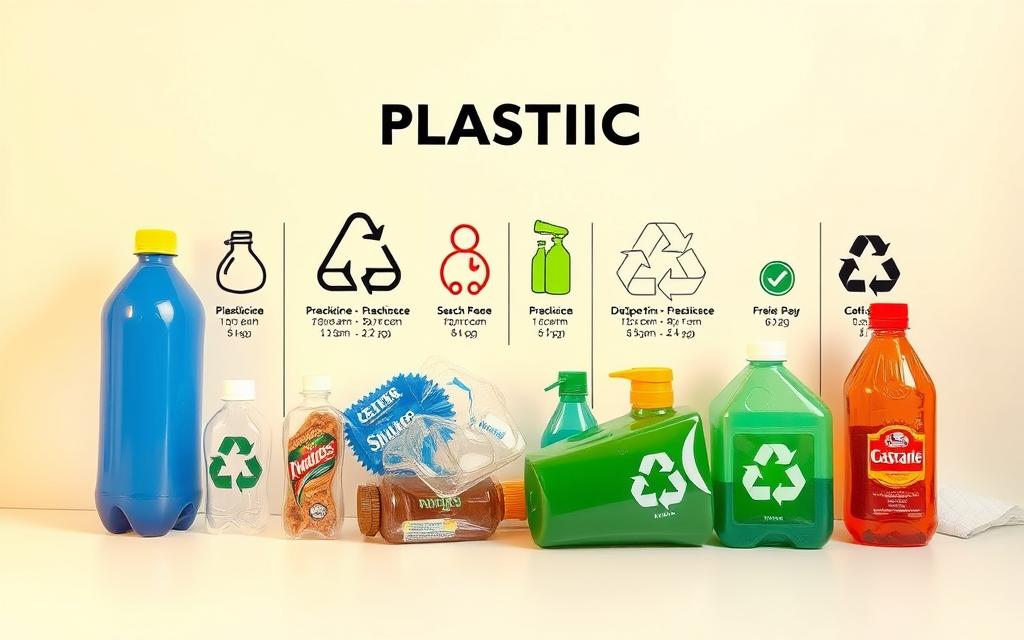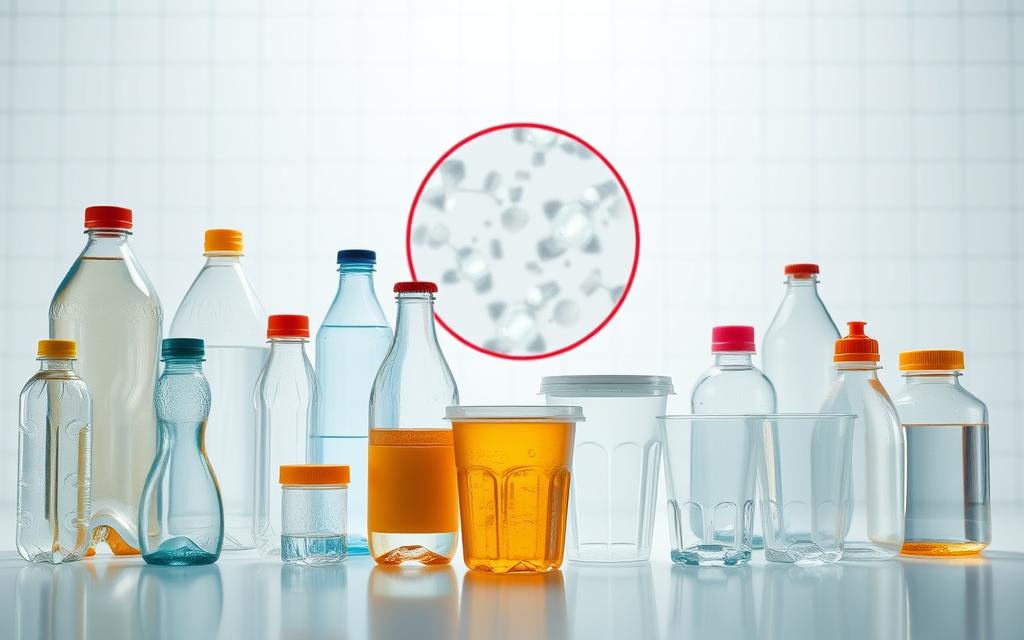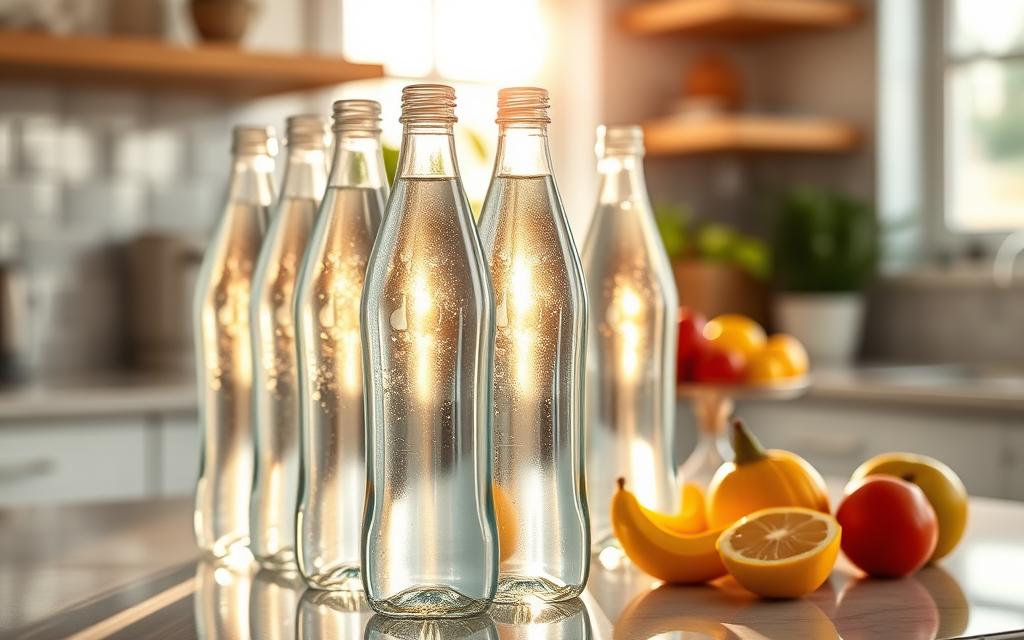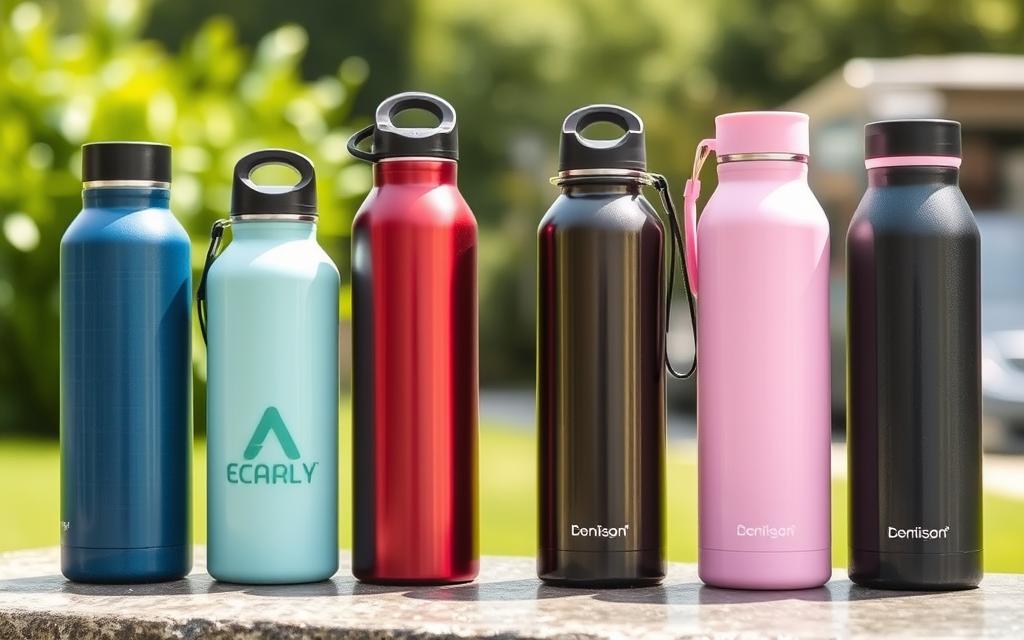Ever thought about the plastics that might harm your health? Millions of Americans unknowingly drink from plastics that can leak harmful chemicals into their water.
Knowing which plastics to avoid is key to staying healthy. Dr. Sheela Sathyanarayana, a pediatrician at the University of Washington, says many plastics have chemicals that can get into drinks.
Plastic is all around us, but not all is safe. Some plastics are risky, more so when heated or used a lot. I’ll help you navigate the world of plastic safety, so you can choose safer containers for daily use.
Key Takeaways
- Not all plastics are safe for drinking
- Chemicals can leach from containers into beverages
- Heat exposure increases chemical migration risks
- Some plastic types are more dangerous than others
- Awareness is the first step to protecting your health
Understanding Plastic Types and Their Risks

Exploring safe drinking plastics can seem like a maze. I’m here to guide you through the different plastics and their risks.
Not all plastics are safe. Some can harm your health, while others are safer. Let’s look at the common plastics you see every day.
The Most Common Plastic Types
Plastics are all around us. Knowing what they are can help you choose better. Here are the main types you’ll find:
- Polyethylene Terephthalate (PET) – usually in water bottles
- High-Density Polyethylene (HDPE) – in milk jugs and some water bottles
- Polyvinyl Chloride (PVC) – not safe for drinking
- Low-Density Polyethylene (LDPE) – in squeeze bottles
How to Identify Plastics
Finding safe drinking plastics is easier than you think. Just look for certain signs that show if a plastic is safe.
“Knowledge is your best defense against harmful plastic exposure.” – Environmental Health Experts
The Recycling Code System
The recycling code system is key to knowing what plastic is inside. Each number in the triangle tells you about the plastic’s safety:
| Recycling Code | Plastic Type | Safety Level |
|---|---|---|
| 1 (PET) | Polyethylene Terephthalate | Generally Safe |
| 3 (PVC) | Polyvinyl Chloride | High Risk |
| 6 (PS) | Polystyrene | Avoid for Drinking |
Pro tip: Colorado’s recent Plastic Pollution Reduction Act shows we’re getting smarter about plastic safety. It’s focusing on harmful plastics like polystyrene.
Why Some Plastics Are Unsafe for Drinking
It’s important to know the risks of plastic containers before you drink from them. Not all plastics are safe, and some can harm your health.
Chemical leaching is a big worry when picking the right plastic for drinks. Some plastics can leak harmful chemicals into your beverage, often under certain conditions.
Chemical Migration in Beverages
Plastics can pass dangerous chemicals into your drinks through chemical migration. This happens more when:
- Containers are exposed to high temperatures
- Beverages are acidic or fatty
- Plastic is old or damaged
Temperature and Chemical Risks
Heat makes chemical leaching worse. I suggest avoiding these actions:
- Microwaving plastic containers
- Leaving plastic bottles in direct sunlight
- Reusing single-use plastic bottles
Health Implications
Potential health risks from unsafe plastics include hormone disruption, reproductive issues, and long-term cellular damage. Chemicals like BPA and phthalates can act like human hormones. This can lead to serious health problems.
Your choice of drinking container matters more than you might realize.
Knowing these risks helps you make better choices about plastic for drinking. This way, you can protect your health.
Plastics to Avoid: A Closer Look
It’s important to know which plastics can harm us. Not all plastics are safe. I’ll tell you about the most dangerous ones.
- Polyvinyl Chloride (PVC)
- Polycarbonate (PC)
- Polystyrene (PS)
Polyvinyl Chloride (PVC): The Toxic Offender
PVC, marked with #3, is very toxic. It has chemicals like phthalates and lead. Being exposed can cause serious health problems. You’ll find PVC in:
- Plastic pipes
- Window frames
- Shower curtains
- Some food packaging
Polycarbonate (PC): A Hidden Hazard
Polycarbonate, marked with #7, is also dangerous. It used to have BPA, which messes with hormones. Even though some are BPA-free, it’s best to be careful.
Polystyrene (PS): The Environmental Threat
Polystyrene, marked with #6, is very common but harmful. It’s in food containers and coffee cups. It can leak styrene, which might cause cancer. It also harms the environment because it doesn’t break down easily.
“Know your plastics to protect your health and the environment.” – Environmental Health Experts
Learning about these plastics helps you avoid harmful chemicals.
Alternative Materials for Drinking
Choosing the right drinking container is key to staying healthy. Safe drinking plastics are more than a trend. They help protect you from harmful chemicals that can get into your drinks.
There are many great alternatives for the healthiest drink containers. Let me show you the best ones that focus on your well-being.
Glass: The Crystal Clear Solution
Glass is a top pick for safe drinking containers. It’s different from many plastics because:
- It doesn’t leach chemicals into your drink
- It keeps your drink’s taste perfect
- It’s easy to clean and safe for the dishwasher
- It offers a clean drinking experience
Stainless Steel: Durability Meets Safety
Stainless steel is a hit among BPA-free water bottle fans. It’s great because:
- It’s very durable
- It keeps drinks at the right temperature
- It fights off bacteria growth
- It’s light but strong
BPA-Free Plastic Alternatives
If you like plastic, there are safer options now. Just make sure to look for labels that say:
| Material | Safety Rating | Best Uses |
|---|---|---|
| Polypropylene (PP) | High | Cold beverages |
| Tritan | Medium-High | Sports bottles |
| High-Density Polyethylene (HDPE) | High | Reusable containers |
Remember, investing in safe drinking containers is an investment in your long-term health.
The Dangers of BPA and Phthalates
Exploring what plastic you shouldn’t drink from is key. Chemical compounds in plastics pose hidden risks. These risks can affect our health in ways we might not know.
Plastic containers can leak harmful chemicals into our drinks. Bisphenol A (BPA) and phthalates are two main culprits.
What is BPA?
BPA is a synthetic compound used in plastic making. Found in polycarbonate plastics and epoxy resins, it can act like estrogen in our bodies. This can disrupt our hormones.
- Commonly used in food storage containers
- Prevalent in plastic water bottles
- Found in the lining of canned food products
The Role of Phthalates
Phthalates are chemicals that make plastics flexible and durable. But, they also pose health risks.
| Phthalate Type | Common Use | Potential Health Impact |
|---|---|---|
| DEHP | Plastic Softener | Reproductive System Disruption |
| DBP | Adhesive Manufacturing | Potential Developmental Issues |
| BBP | Vinyl Flooring | Potential Hormone Interference |
Health Impacts of Exposure
Long-term exposure to these chemicals can cause serious health problems. Studies link BPA and phthalates to hormonal imbalances, reproductive issues, and cancer risks.
“The chemicals we cannot see might be the most dangerous ones we encounter daily.” – Environmental Health Research Institute
To stay safe, choose glass, stainless steel, or BPA-free containers. This can help reduce your exposure to harmful substances.
How to Read Plastic Labels and Codes
Understanding safe drinking plastics can seem tough. I’ll guide you through plastic labels and recycling codes. This will help you pick the best plastics for your drinks.
Deciphering Recycling Codes
The recycling codes on plastic tell you if it’s safe to drink. These small numbers inside a triangle symbol show what the plastic is made of. They also hint at its safety.
- Safest Options: Look for codes #2 (HDPE), #4 (LDPE), and #5 (PP)
- Avoid codes #3 (PVC), #6 (PS), and #7 (PC)
What to Check on Labels
When picking plastics for drinks, look beyond the recycling code. Check for these safety signs:
- BPA-free certification
- FDA-approved materials
- Food-grade designation
Identifying Safer Plastic Choices
Opt for HDPE and PP containers. These are safer and less likely to leak harmful chemicals into your drinks.
Pro tip: When in doubt, choose glass or stainless steel containers for the safest drinking experience.
Safe Practices for Drinking from Plastics
Using safe drinking plastics needs careful thought and action. BPA-free water bottles are common now. But, it’s key to know how to use and keep plastic containers safe for your health.
Here are important steps to protect yourself when using plastic containers:
- Avoid exposing plastic containers to extreme temperatures
- Use BPA-free water bottles whenever possible
- Replace worn or scratched containers regularly
- Hand-wash plastics to minimize chemical breakdown
Smart Tips for Plastic Container Use
Here are some useful tips for using safe drinking plastics:
- Check recycling codes before purchasing new containers
- Never microwave plastic containers not labeled microwave-safe
- Store liquids in glass or stainless steel when feasible
Storage Best Practices
Proper storage helps your BPA-free water bottles last longer. Keep them in cool, dry places. Avoid direct sunlight and heat sources.
“Small changes in how we handle plastics can make a big difference in our overall health.” – Environmental Health Experts
Reducing Plastic Dependency
I suggest slowly switching to safer options like glass, ceramic, or stainless steel. These choices offer safer drinking and help the environment.
Eco-Friendly Alternatives to Plastic
More people are looking for healthier drink containers that are good for both us and the planet. Switching to sustainable drinking options is not just a trend. It’s a change we need to make.
Choosing BPA-free water bottles is more than just about staying safe. It’s about taking care of our environment. Let’s look at some green alternatives that can really help.
Benefits of Reusable Containers
- Reduces plastic waste in landfills
- Minimizes carbon footprint
- Saves money long-term
- Promotes healthier drinking habits
Sustainable Materials to Consider
| Material | Pros | Durability |
|---|---|---|
| Stainless Steel | Highly durable, no chemical leaching | Excellent |
| Glass | 100% recyclable, pure taste | Good |
| Bamboo Composite | Renewable, biodegradable | Moderate |
How to Make Eco-Conscious Choices
Choosing sustainable options is easy. Start small by getting a good, reusable water bottle. Look for ones that are BPA-free and made from stainless steel or glass.
“Every sustainable choice is a step towards a healthier planet.” – Environmental Advocate
In Colorado, the Plastic Pollution Reduction Act (HB 21-1162) shows how local governments are stepping up. By 2024, they will ban polystyrene food containers. This is a big step towards taking care of our environment.
Staying Informed About Plastic Safety
Understanding the dangers of harmful plastic containers is key. The world of plastic toxicity risks is always changing. New studies help us make better choices for our health and families.
It’s important to follow scientific research on plastic. Groups like the National Institutes of Health and Environmental Protection Agency share important findings. I suggest keeping up with scientific journals and health publications for the latest on plastic safety.
Supporting laws that improve plastic safety is also vital. Organizations and groups are fighting for stricter rules on harmful plastics. By getting involved, signing petitions, and backing safer plastic efforts, we can help protect public health.
I always try to learn more and take action. I check sources like Consumer Reports and scientific journals for updates on plastic safety. Remember, knowing the facts helps us protect ourselves and our loved ones from plastic dangers.



